What inspired me to move from Obsidian Publish to Microblog?
TL;DR: a gateway to a thriving online presence
What if I told you there is a tool that can replace your blog, website, newsletter, podcast, bookshelf, and more? 🤯 It’s even compatible with the ActivityPub protocol.
In a recent article, I discussed how owning a domain and using permalinks can help you seamlessly move from one hosting service to another without losing your audience. Then I published another article devoted to describing a similar approach for your social media presence
Well, there is a way to combine the best of both words in a single place. Better yet, what if you could also include other services, like a newsletter? Have I mentioned that the price is a fraction of what you would pay for a combination of similar services from other companies?
Since this is too good to be true, I feel like a disclaimer is needed. No, this is not a sponsored post. I paid for my subscription, and no one at Micro.blog had any input on this article or any content I’ve been publishing about them. I’m doing it because, as you already know, I’m an enthusiast.
Anyway, I hope you’ll find the information below helpful.
My previous set-up
I have an institutional website for many years, but have been posting my articles on Medium for a long time to take advantage of the algorithm. Two YouTube channels, one in Portuguese and another in English, a newsletter hosted by Substack, and a presence on multiple social media platforms.
I believe that diversifying like this helps spread the word because I can take advantage of algorithms from multiple platforms. However, my entire business is run by myself, and things can quickly become overwhelming. So much so that last year I was forced to pause my newsletter for several months.
Why Obsidian Publish didn’t work for me
When I moved my website from WordPress to Obsidian Publish, I was trying to simplify things by having my notes and the website in the same tool. But if I’m being honest, it ended up creating more work. Not because of the publishing process, which is easy and straight-forward. The problem was me. I love taking notes, so I suddenly felt compelled to share as much as I could, and that came with its own set of complications.
Instead of just taking notes, I was constantly thinking about how to structure my notes to have them ready for use and, at the same time, good for publishing. Furthermore, my folders structure became a little chaotic due to the numerous additional files needed to create a website. I was constantly afraid of accidentally moving or deleting files.
There’s no way to have a blog when using Obsidian Publish, but I was kind of okay with that because Medium was my blogging platform at the time. I also read numerous complaints about SEO, but I’m not a specialist on this topic and cannot say much about it. However, the final hurdle was the verification process at Mastodon, which could never identify the needed code because of the way Obsidian Publish builds the website.
I couldn’t care less about verification, but I have already been impersonated, and unfortunately, some people following my YouTube channel in Portuguese were scammed. After that, I’ve been constantly trying to do all I can to prevent it from happening again.
What’s next?
In 2022, I tried Micro.blog, but it lasted for less than a year. It was the way the platform handled engagement that made me give up on it. If you would like to learn more about it, have already explained everything in more detail in another article.
For those of you who are not aware of Micro.blog, it’s a complete solution. It is a space to share short posts like ‘tweets’ and pictures, a blog, a website, a newsletter, a podcast hosting service, and many other amenities like bookmarks plus a ‘read it later’ with a highlights feature, a bookshelf, and more. And the price is amazing. US$5 or US$10, depending on the features you need. To learn more about it, I suggest you watch the video below. But beware that it doesn’t cover all its potential.
I still have my two YouTube channels, and they are not going anywhere. But I reactivated my blog on Micro.blog. I won’t stop publishing the articles on Medium, but I started adding a Canonical Link.
Micro.blog can be set to share the same content on other websites, like Medium. However, for now, I’m doing it manually.
ActivityPub
Regarding the newsletter, I am still using Substack, but I also intend to transition it to Micro.blog in the future. However, the feature in which I’m most interested is precisely the one that made me live in the first place. The blog is compatible with ActivityPub and, as explained in another article, anyone can follow it from any Fediverse service.
The strategy Flipboard is using inspired me. Their Mastodon instance — flipboard.social — works as a Twitter alternative, where the community can share and interact with one another. As for flipboard.com, it is being converted to be 100% compatible with the ActivityPub protocol. If all of this seems too much, please watch the video below. It may help you better understand the terminology I used above.
My plan is to rebuild my Twitter community on Mastodon, while Micro.blog will host my blog, site, and other services, acting as a central point to help people access all the content I’m constantly sharing online.
Nostalgia
This doesn’t necessarily count as a rational reason, but since when is feeling at home something that’s rational? When I first tried Microblog in 2022, I noticed a familiar face among the team: Jean MacDonald. I had the opportunity to meet here only twice for brief moments during the 2013 and 2014 Evernote Conferences. Nevertheless, the conversations we had were so pleasant that those moments remain etched in my memory to this day.
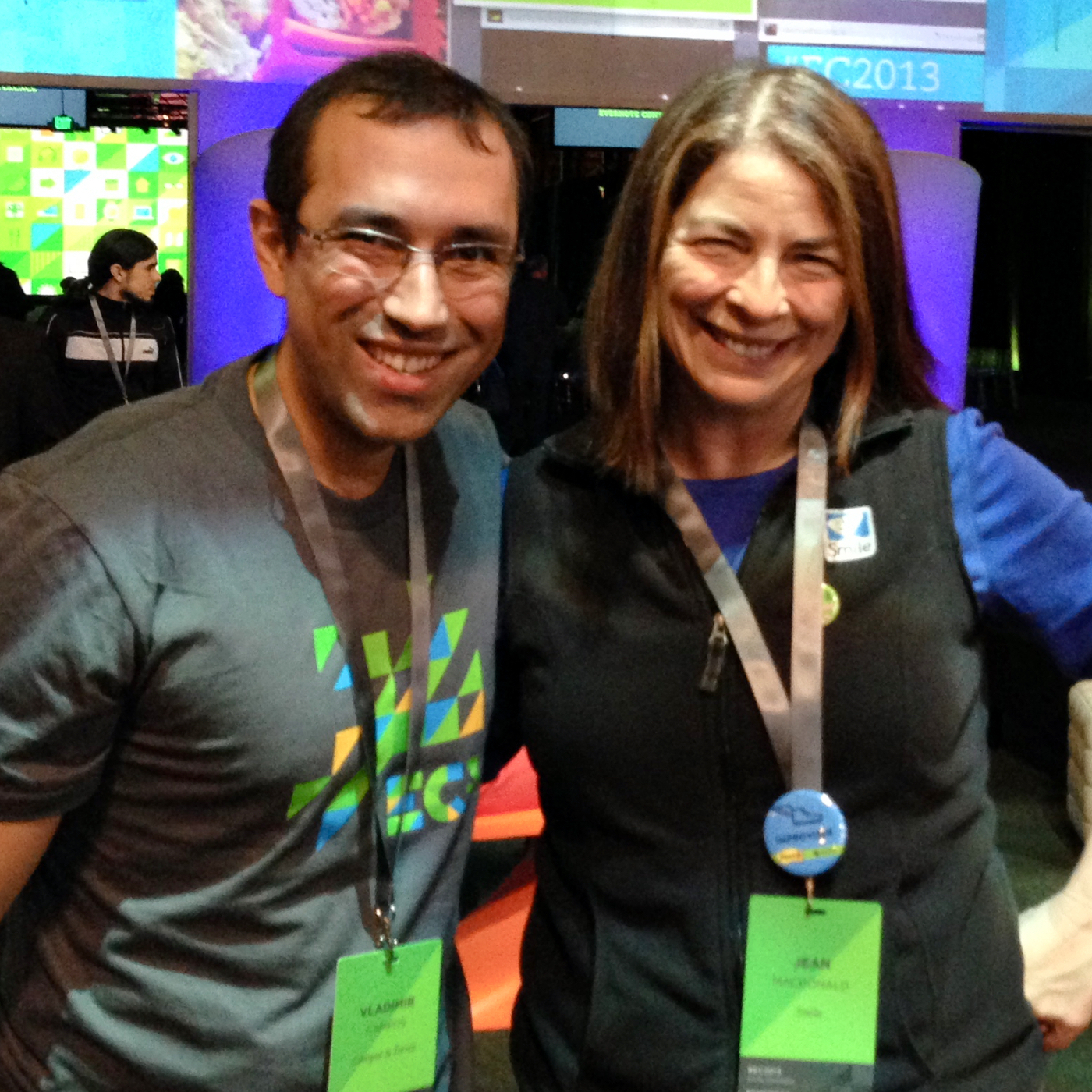
In conclusion, there’s nothing terribly wrong with Obsidian Publish. On the contrary, during those months I used it, it proved to be a fast and reliable service. But there’s no blog or ActivityPub there, and those are some reasons why Microblog is gradually becoming my online home.
Another reason, as I mentioned before, is that Micro.blog can work as a hub for publications. At some point in the future, when I finish my migration process, I’ll start using it to automatically cross-post content to other social media platforms.
Combined with all the other benefits I mentioned above, I’m expecting Micro.blog to significantly reduce the work I currently do every time I publish a new article or video.
Obsidian's new editor is a big step in the right direction
As a user, I enjoy Markdown. However, as an instructor, I almost hate it. Most of my clients find it challenging to understand and use, especially in a world where every basic text editor has a formatting bar.
We, the Markdown enthusiasts, see it as a great invention, and it is, but it is meant for people like us. My first computer was an Apple II+ where I learned to write programs in Basic. If you are a Markdown lover, I bet you have a similar background or passion for technology. But how many people do you think there are like this in the world?
The good news is that the Obsidian team seems to be steadily figuring out a way to allow users to pick their preferred text formatting method without any hassle.
My background
I learned how to create my first website back in the 1990s by looking at other people’s source code. But that’s as far as I went. I was unable to learn any other advanced programming language, even those that are only slightly more complicated than HTML. However, having this background made me look at Markdown and find it to be the easiest thing to learn and use on the planet.
I’m confident to say that people with similar backgrounds, for example, Excel enthusiasts, will also find Markdown super easy to learn and use. However, that is too much for people who only use computers as basic tools. I know this because I have seen it happen to my clients time and time again.
Trello is a great tool I use a lot in my consulting business, but it took them ages to adopt a regular text editor. Before that, the only way to format text was by using Markdown, and only a very few of my clients were willing to use it. It was rare that anyone took the time to learn it.
An entry barrier
All that said, I always saw Markdown as one of the biggest barriers to any non-tech-savvy person thinking of adopting or switching to Obsidian. Again, I’m not making assumptions here. I don’t have numbers, but I’m constantly hearing complaints from clients and reading comments on my videos and articles about how complex it is.
It’s true that one has to memorize just a handful of symbols to use it, but that’s not natural, especially when all the other text editors regular people use have a formatting bar. Most people don’t even use Ctrl+B, I, or other formatting shortcuts. Clicking on icons is significantly more intuitive.
A big step in the right direction
If you haven’t yet, I invite you to watch the video below and stay with me for a moment while I move items from one column to another on a table using Markdown. No matter how much you love Markdown, that’s insane! It’s a huge waste of time.
Thankfully, Obsidian 1.5 added a terrific table editor while keeping all the Markdown behind the scenes for the enthusiasts. Another important addition is right-clicking a word to format it or right-clicking on the note to add items like tables, paragraphs and many others. Again, the Markdown is still there.
The gradual adoption of more familiar ways to format text is a big thing. In my opinion, this is the way to go. It will attract more non-tech-savvy users while keeping the Markdown layer under the hood.
Great move, Obsidian!
The first book of 2024
I still prefer eBooks and my Kindle for a multitude of reasons, but bookstores and used bookstores are still the kings of discoverability. I found this one in a random store during my last trip, and I am really enjoying it (affiliate link).
Prisoners Of Geography: Ten Maps That Tell You Everything You Need to Know About Global Politics by Tim Marshall.
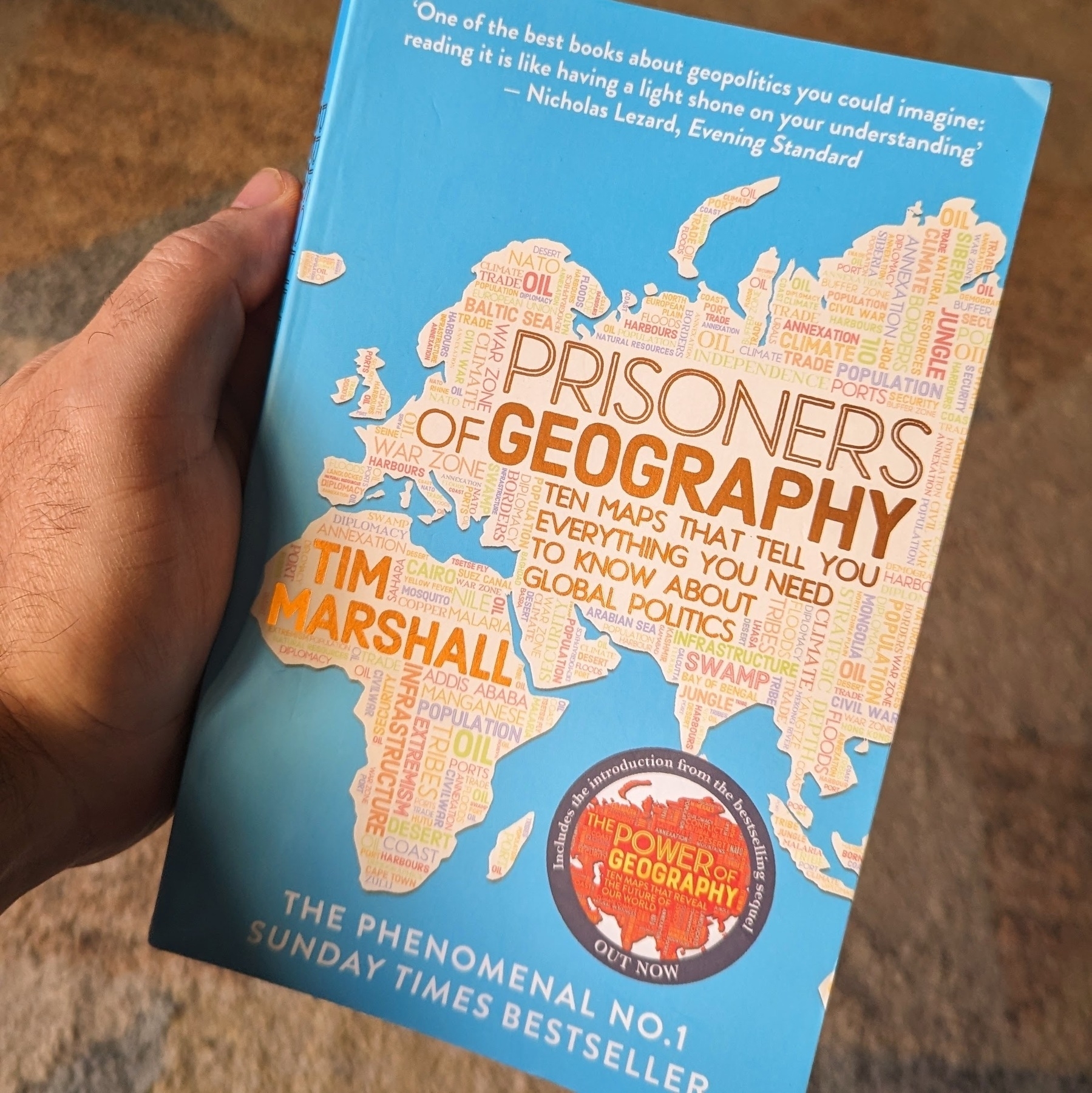
Will 2024 be my first year without Evernote?
I think it’s fair to say that everyone was a bit astonished when the news broke on the third day of 2023. Bending Spoons, a company barely anyone knew about, had acquired Evernote.
For the past 15 years, I have never considered leaving Evernote. To be more precise, the thought never crossed my mind. Now it looks like 2024 will mean more to me than just a new year. Maybe it will be a year without Evernote. But it’s rare for something so big to happen suddenly. We have to go back to the beginning of 2022 to understand what’s going on.
I was already experimenting with Obsidian for my video production workflow when some of my clients asked me to help them build their workflows on Obsidian. That ended up starting a feedback loop of fresh ideas and more experimenting and teaching. Long story short, by the end of 2022, this learning and teaching system was at full speed. Then, boom! The acquisition news in January 2023. And, let’s not forget the chaos Twitter was in because of its own acquisition. What if Evernote experienced the same fate?
There you have it. It was a perfect storm forming before my very eyes.
What I’m trying to say is that it’s rare for only one event to cause a big change. It is usually the culmination of many small things happening simultaneously that creates the perfect conditions.
Most of my notes—about 80% of them—are still in Evernote. But if I’m quoting Pareto, the 20% of notes I’m using 80% of the time are already in Obsidian. And this makes all the difference. When I need to find something, chances are that Obsidian will have it. Which ended up helping me create the habit of opening Obsidian first. Oops!
Another important aspect of Obsidian is the fact that the mobile clients are fully functional. During short trips or vacations, I do not bring a computer with me, and I can still use Obsidian on my iPad as if I were at my office computer.
It’s not all roses, though
I was an early adopter of Postash.io back in 2014, and I loved the fact that I could convert any of my Evernote notes to pages of a website or blog posts. Sadly, the service never worked properly, and I ended up going back to a conventional website hosting service. Obsidian Publish seemed like the perfect opportunity to try that again, but although it is a very reliable service, it came with its own set of problems. As you already know, I went back to a traditional website hosting service. But this is a story for another day.
For the moment, I will leave you with this. It’s more likely than not that 2024 will be the year I switch from Evernote to Obsidian.
Happy New Year!
L'arbre des 3 Frontières
Thanks to the Schengen Agreement, I started my day in Luxembourg, visited France for a while, and then had lunch in Germany. The fact that anyone in the EU can freely cross borders is a wonderful thing that should never be taken for granted.
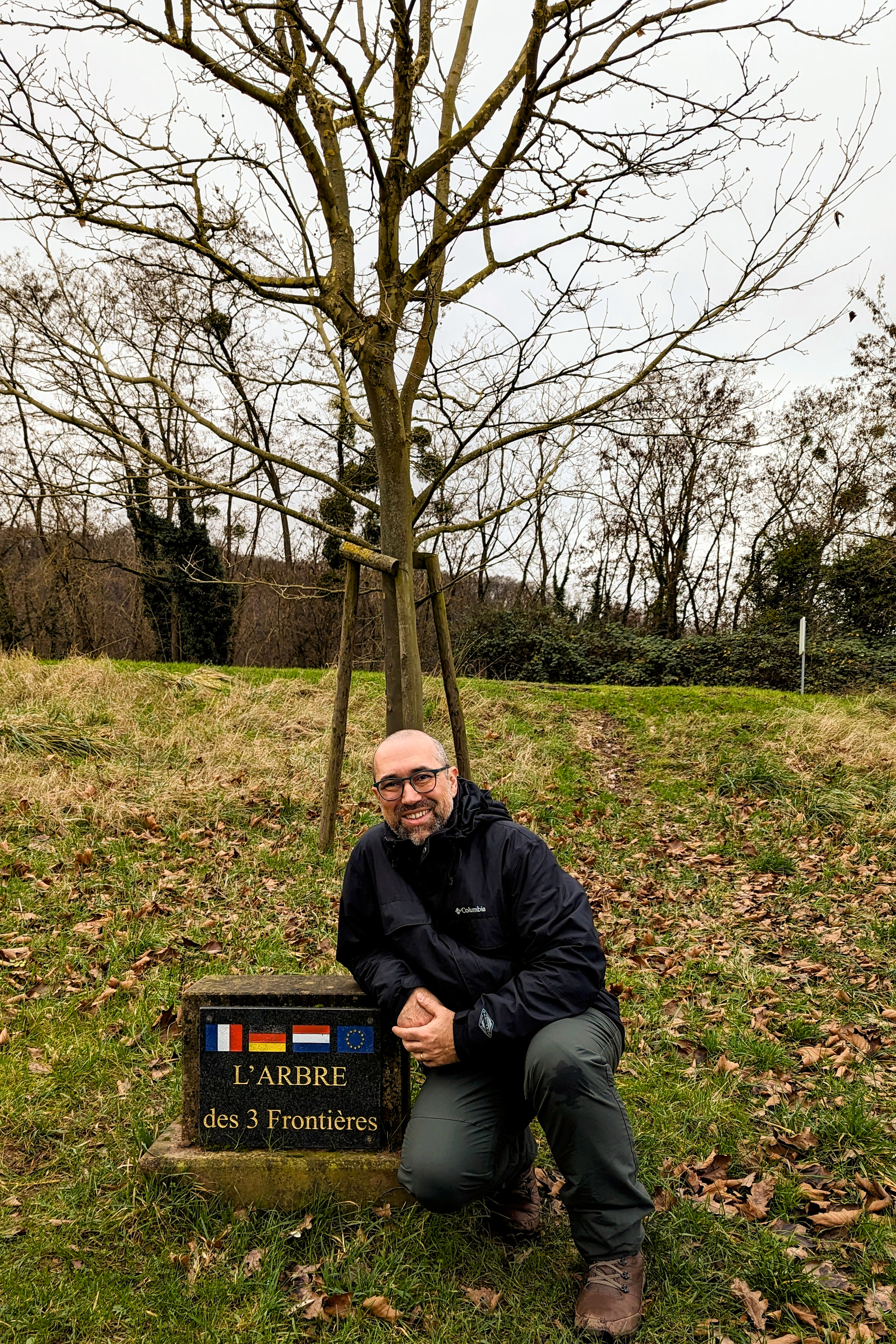
My travel coffee kit
I still use my original AeroPress to make coffee in my office, and for a long time, it was the one I took with me on every trip. When the AeroPress Go was released, I had to buy one and include it in the small 🫣 kit that I always travel with to be able to brew my own coffee every day.
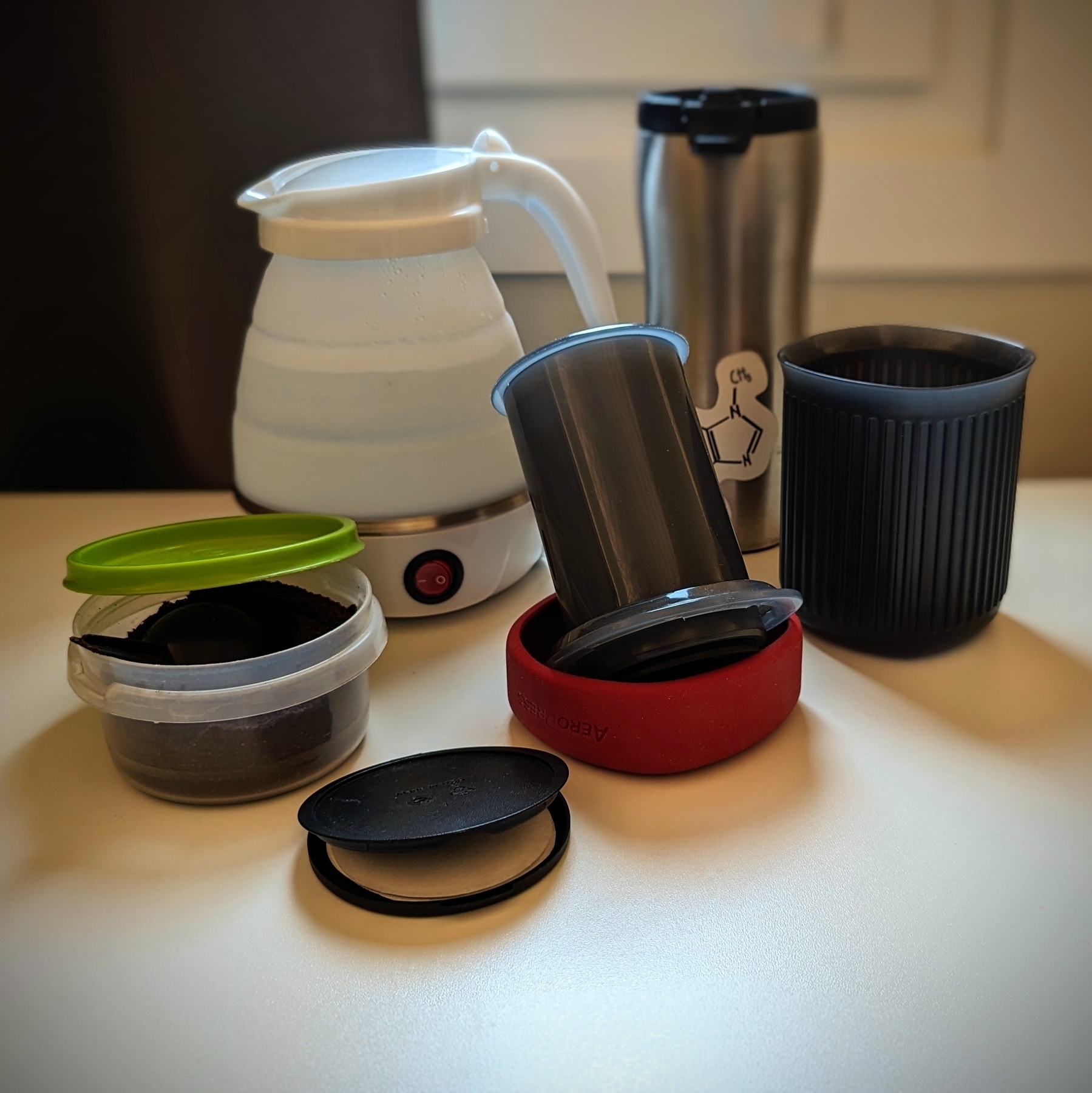
Back to the Source
Revisiting Weaving the Web by Tim Berners-Lee
To give you a sense of how long ago I read the book Weaving the Web, I still had a Walkman lying around, and since I accidentally picked it up in cassette format, that’s how I “read” it. Yes, you got that right: cassette tape.
Regardless, I remember hearing Tim Berners-Lee explain that his original concept for the Web was a more interactive knowledge-building and linking process. I don’t recall his exact words, but this was the idea. At least, this is what my memory tells me. Which reminds me of another great book, Memory Illusion by Dr. Julia Shaw. But I digress.
That stuck with me for a long time because, for many years, all we had were websites with static pages. No interaction at all. It was more like a one-way knowledge flow, but it was a start. Then came the blogs and the comments, but it still didn’t feel like what he meant in his book. When social media started gaining popularity, I thought to myself, Maybe this is it. Well, I was wrong. We ended up with a lot of “islands” and too much misinformation.
I don’t think a Web based on the ActivityPub protocol is precisely what he meant, but connecting all these online “islands” feels to me more like his vision. Another step, if you will.
Anyway, it’s been too long since I read this book, and I’ll use the last week of 2023 to revisit it. It’s a great book! Dr. Shaw’s book is also excellent, but it’s more recent, and I have already read it twice.
That’s it for this one. I hope you have a lovely day!
Future-proofing my online presence
My thoughts and opinions on ActivityPub and the Fediverse are numerous, and I am already working on an article to share them with you. For this one, the plan is to explain my strategy to future-proof my online presence.
If you don’t know what ActivityPub and the Fediverse are, please watch my recent video about this topic. But the most important information to understand is that one can follow and be followed, as well as engage, regardless of what social platform is being used.
Many services have been compatible with the ActivityPub protocol for a long time now, but I don’t think we can deny the fact that if large corporations adopt it, the chances of it becoming mainstream are higher. And based on the recent announcement by Flipboard and the tests being conducted by Threads, I’m pretty sure this is what’s happening right now.
Again, I suggest watching my recent video on the topic to understand the details and implications. For now, let us discuss the reasons behind my choice of Micro.blog and Mastodon.
Micro.blog
I believe that Micro.blog is a link between the old Internet, before social media, where people used to write on websites and blogs, and the new Internet that is all about sharing everything.
At Micro.blog, you can make a website with static pages and and also have a blog. The cool thing about the blog is that it uses the ActivityPub protocol. This means that anyone using any ActivityPub service can read and engage with your posts.
But there’s more, or, should I say, less? If you read Manton Reece’s book about starting a Micro.blog, or follow him online, you’ll see that he is really into writing short posts. It is also evident in the company’s name and the blog feature on Micro.blog.
If one writes simple posts, such as tweets, they will be added to the timeline, like what happens on Twitter and other similar services. On the other hand, if a long-form text is created, that will become a blog post like this article you are reading. However, it will also be added to the timeline with a link to the article. And, once again, that timeline is compatible with ActivityPub.
All these means that someone, say, on Mastodon, can follow and engage with all the posts without ever being a Micro.blog user. You can use my blog to try it out. Just look for @vladcampos@vladcampos.com on your preferred Fediverse platform.
There are already many great interviews with Manton Reece about Micro.blog out there, but I’m thrilled to share that he recently accepted an invitation to have a conversation about all this on my YouTube Channel.
But if Micro.blog is both services in one, why would I need Mastodon? Well, a year ago, I tried using it alone, but I had no success. I left because of a design decision. There are no likes or re-posts on the Micro.blog timeline. To explain why I care about it, let’s talk about Mastodon.
Mastodon
When I first heard about Micro.blog, I was already a Mastodon user, where I was building a new community after leaving Twitter. On doing so, I quickly learned how important likes and re-posts are. Because of them, I got to know so many nice people re-posted by someone I was following. The same thing happened the other way around. People re-posting me on Mastodon helped me get noticed by others.
Nevertheless, I fully understand Micro.blogs decision. The goal is to stimulate conversations, but, to be honest, I felt very isolated there. And at that particular moment, I did not have a significant number of people following me on Mastodon, and I still do not. Until these days, I keep discovering interesting people and communities through re-posts.
How is this future-proofing my online presence?
First of all, ActivityPub is a W3C protocol. Then, there’s the fact that major corporations are beginning to embrace it. But the most important reason is that ActivityPub-compatible social media allows you to move between different services and bring all of your followers with you. Let’s say that in the future, Micro.blog adds likes and re-posts and I decide I want to leave Mastodon. I’ll be able to easily do it, bringing with me all the followers, whom, by the way, I prefer to call community.
This is such a win-win situation. Whenever and wherever it pleases me, I am free to move, and I don’t have to ask anyone from my community to move to a different social media platform. Furthermore, if they also wish to move somewhere else, that’s fine. As long as it is compatible with the ActivityPub protocol, neither technology nor CEOs will prevent us from keeping in touch with each other.
The Plan
My website has already been migrated to Micro.blog, but I will continue to post on Medium, which is, incidentally, also in the process of adopting the ActivityPub protocol.
In December 2024 I started the processo of moving my site to Obsidian Publish. In August 2025 I moved back to Micro.blog
Regarding micro-posting, I’ll be doing it on Mastodon. So, if one wishes to follow only my articles or only my micro-posts, they can do so. Or, they can also follow both. And the best part is that anyone can follow and interact with me using any ActivityPub-compatible service. This is absolutely remarkable!
What went wrong with Evernote? How did we get here?
I expect negative comments on every video or article I publish about Evernote now. Sadly, talking about it makes me feel anxious.
I don’t think Evernote is doomed, but there is a profound shift in perception going on. It used to be that going to the Evernote Conference was the most important moment I looked forward to every year. It was great to see my friends, clients, developers, and the Evernote team.
Furthermore, sharing news from the conference or anything else Evernote released throughout the year had such positive vibes. Now, it’s hard to ignore all the negativity out there.
But the mood didn’t shift at once; it rarely does.
It all started many years ago
In July 2015, Phil Libin stepped down as CEO, and Chris O’Neill initiated a series of changes that made many of us, myself included, uneasy with the future of the company, or, in other words, our notes.
Evernote had a family of companion apps, and the new CEO gradually discontinued most of them, making many of us unhappy. But moving Evernote’s database to Google Cloud and the layoffs kicked off the first negative wave I’ve ever seen. At least, I do not recall anything similar during the Libin years.
I have to believe that from a financial standpoint, moving to Google servers was the best course of action. Even Apple used Google’s service in the early stages of iCloud. And I think they still do. However, the public’s perception was distorted by the way the media covered all the other CEO decisions.
For instance, I recall reading articles that referred to Evernote’s headquarters as a “ghost town.” I was furious about that; it made no sense. Back when Libin was CEO, or, in other words, before the layoffs, I visited the company and can attest that the building was not fully occupied. As far as memory serves, floors one and two were completely empty. Not even desks! The idea was to have enough room to grow in the future.
Nevertheless, I can relate to the anger and frustration people felt. The way the story was told made it hard to tell the difference between noise and reality, which leads me to the topic of communication. I’ve always found Evernote to be terrible at conveying decisions to its users. And the problem is still present. For instance, I believe that transferring operations to Europe was an excellent decision, but again, the public perception was different.
When you are hosting people’s memories, you don’t have the luxury of being as secretive as Apple or carless as a cable TV announcing the new version of its app. Every decision has to be over communicated.
Building your brand out of a domain name
TL;DR: Social media is a great space to become known, create authority, and grow your audience, but you need a home base that is yours. Buy a domain, create a basic website if you don’t want to spend too much time on it, and always, always promote it on all the social media services you are using.*
How having my own domain gave me so much freedom
Like many of us, I have grown tired of social media, and in recent years my posts have shifted to basically promoting the content I create and getting in touch with other creators and potential partners.
About 20 years ago, after using Geocities and other similar services, I decided it was time to establish a web presence by creating a self-hosted WordPress website with my name as the address. When that became too technical for me, I switched to WordPress.com. But I didn’t stop there. I decided to give Squarespace a shot long before it became the recognizable name it is today, primarily because I wanted a more professional-looking website.
Many years after that, I moved to Google Sites because I was already paying for it on my Workspace subscription. It ended up not working out for me because of some limitations, and last year I went back to WordPress to give it another try.
Between all the switches described above, I also tried Micro.blog and Postash.io for a while. More on this shortly. Finally, last week I moved to Obsidian Publish.
Despite all these transitions, people could always find me visiting my website. Having my own domain and using something called permalinks made this possible.
What is a permalink?
If you search for ‘what is a permalink?’ on Google, many of the results will be explanations based on the SEO benefits. That’s a good reason on its own, but I also think they are a great tool for moving your website to another hosting service. Let me tell you what I mean by this.
This was precisely what I did when going from one service to another. Many times I used the moving opportunity to remove some posts and rearrange others. But because the permalinks were kept the same, rearranging pages in different places didn’t break anything.
Here’s an example:
For a long time, I have had a page listing some of the books I have already read. The address has been vladcampos.com/library since I created it. But when I recently moved to Obsidian Publish, I decided to rearrange parts of my website structure. I now have a ‘toolbox’ directory containing the ‘library’ and other pages, like one for my filmmaking gear. So instead of the address above, I ended up with:
vladcampos.com/toolbox/library
Because the page is now located inside the toolbox subfolder, I set vladcampos.com/library as a permalink. Now, if you type vladcampos.com/library, the website will present you with the correct page. In other words, old visitors and Google Search will still find the page.
Yes, you can set up permalinks on Obsidian Publish.
Why did I move to Obsidian Publish?
Back in 2014, a company called Postash.io released a service to create blog posts from Evernote notes. All one had to do was add the “publish” tag, and the note would be converted into a blog entry. And, yes, removing the tag would unpublish the note.
Until this day, I still believe that this is a genius solution because all of my articles start with an idea that I write down and work on using an app like Evernote or Obsidian.
Postash.io is still available, but it hasn’t been updated in a long time and doesn’t have many important features a website need. That’s why I used it for less than a year back then and quickly moved on. However, as a concept, Postash.io still makes a lot of sense for my workflow, and that’s why I recently moved my site to Obsidian Publish.
Publishing became so much easier, but there are many other reasons that I’ll explore in future articles and videos. Furthermore, having the original posts on my computer as notes is like having a backup of a backup, and this is pretty comforting.
What were the lessons we learned today?
Social media platforms come and go. Use them to your advantage, but make sure you have a home base — a website with your own domain name. And if you wish to experiment with other hosting services, permalinks can help you keep all the old links working.
Without experiencing the unknown variables, it’s impossible to organize efficiently
The best way to organize things, whether they’re physical or digital, is to accept the mess for a while. That’s why my strategy for organizing things is to always start with a messy environment, a blank canvas to play with. However there’s a catch: I have to pay close attention to what I’m constantly searching for and using.
It is only after rearranging things again and again and learning my necessities that I am finally ready to begin building the system that will meet my needs. But, there is no doubt in my mind that that will not be the final version. The world around us constantly changes, and we must adapt to keep up.
The tricky part is figuring out the exact moment when the messy stage has to give way to some order. I like to use a concept I borrowed from economics: Transactions Costs. In other words, if the mess is making me less and less productive, it’s time to pause and organize by choosing the best workflow I’ve come up with so far.
If you haven’t already, I encourage you to watch the video below. It’s about an Evernote notebook being built from empty to fully functional. It started out messy, and I added tags, links, etc. as I learned what I was constantly looking for and using.
And like I said before, it’s a strategy that works in both the digital and physical worlds. Last week, I finally organized my workbench inspired by the way I moved objects around when I was working on the Apple IIe restoration project. I’m pretty happy with the final result, but I already had new ideas for it.
The messy approach is also a way to foster creativity. There are many good books about this subject. There’s one literally titled Messy, but The Click Moment and Algorithms to Live By also discuss it.
Moving things around forces us to look at a problem from a different perspective, which helps us come up with unexpected solutions. But it is important to keep in mind that the project on which we are currently working is not our sole concern. In my case, the messy workspace was also a project in progress.
Take a look at the shelf and the soldering station; they are all made from scrap wood. By the way, I love that cool industrial vibe. You can even tell from the black circles on one of the shelf legs that the piece of wood was once below the table glass. It was a test; I was trying to figure out how many crossbars I needed to keep everything stable and I ended up replacing the studs with the thicker ones that are there now. As for the rest of the replaced pieces wood, they were used on other projects.
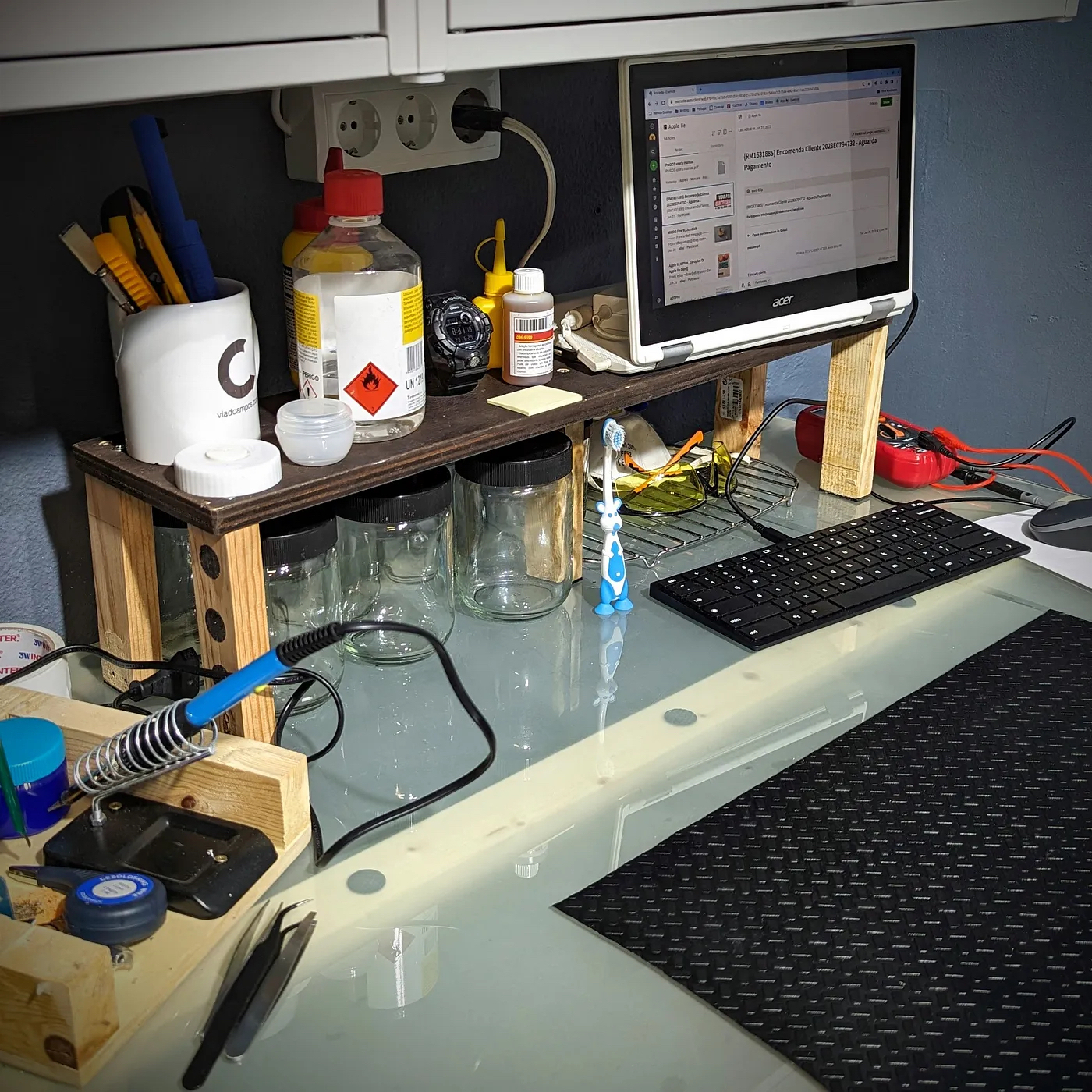
But there are more repurposed materials. The desk itself is made up of the top glass of an old kitchen table, supported by some cheap Ikea trestles. As for that Chromebook, it will not get Chrome OS updates anymore, but it is still good enough for Google searches and the Evernote web client.
So, the next time you are working on a complex project, don’t be too hard on yourself. Every so often, a little mess is what you need to unlock a solution that was always there, but you couldn’t see.
By the way, switching to another project also works, but that’s a story for another time.
Generations
After helping me fix the issue with the ROM chips a few weeks ago, my son got to play Gremlins on the Apple IIe.
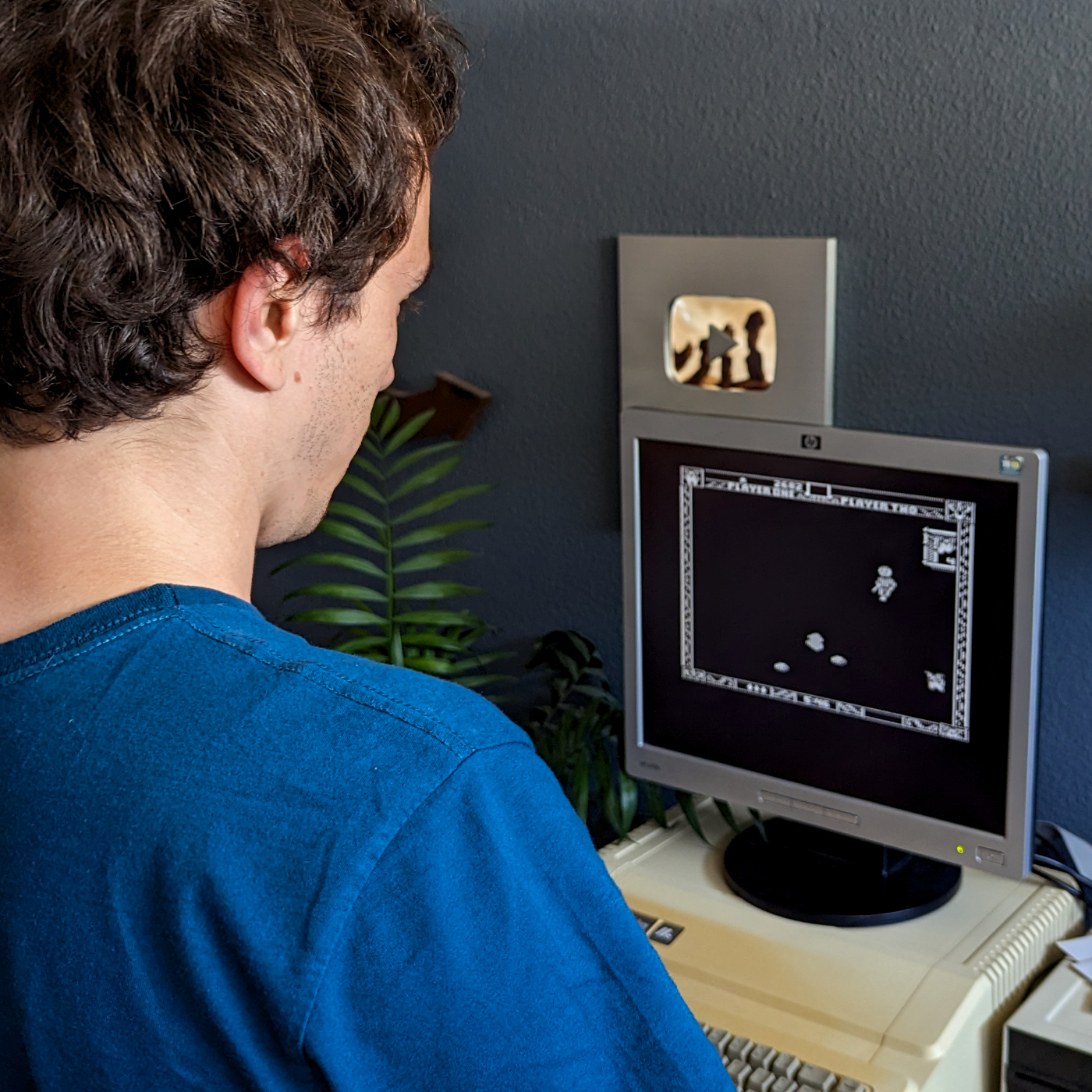
Is your computer truly yours?
It is remarkable how contemporary technology is built around the loss of control over our devices. In contrast, the Apple IIe, which is considerably older, is so open to experimentation and modifications.
One or two years ago, I wanted to try ChromeOS Flex and decided to install it on my old MacBook Air 2012. I enjoyed the process of installing it and had fun with the OS. Now I needed macOS back on the computer to be able to use it on the Apple IIe restoration project, but when it came time to reinstall macOS, things didn’t go well at all.
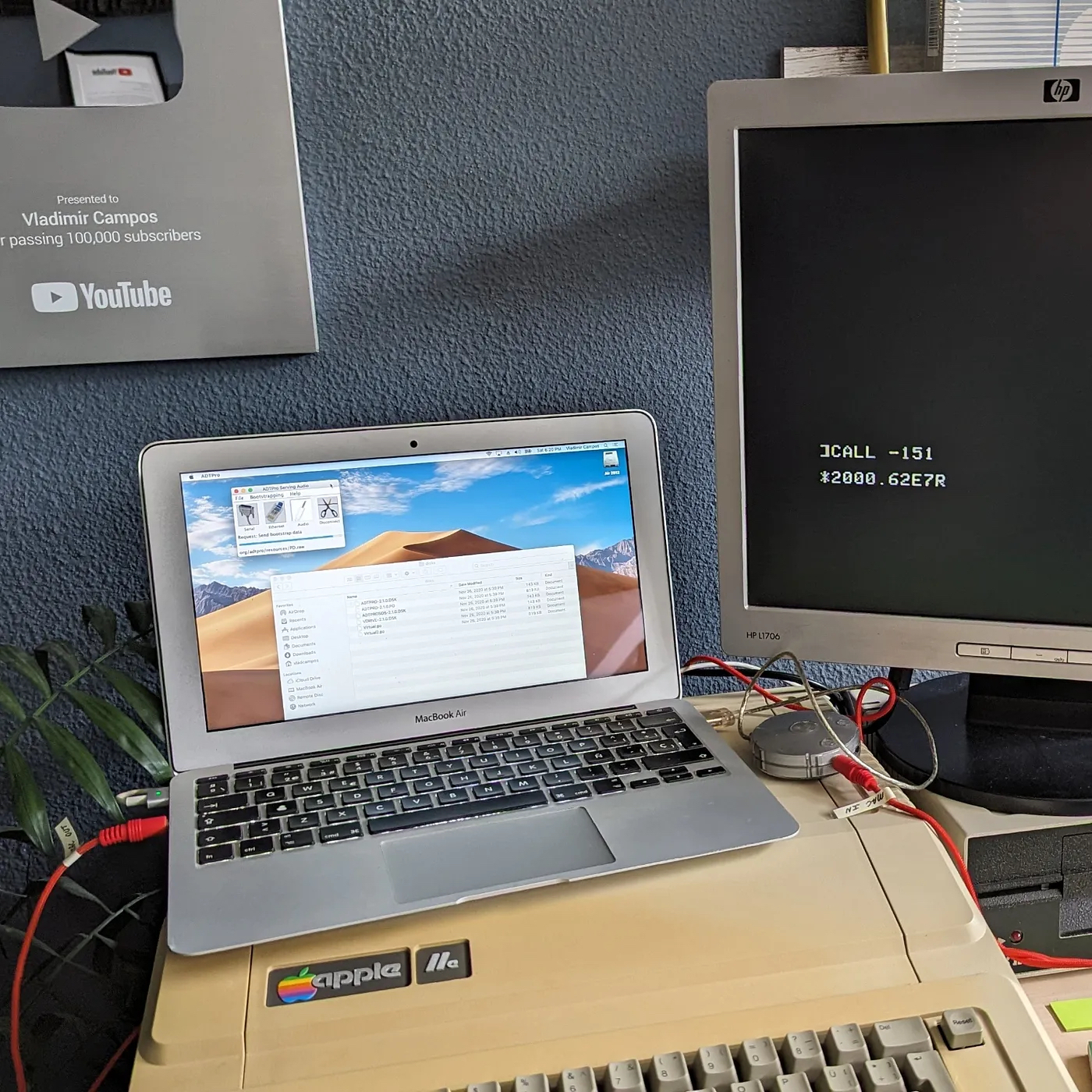
macOS Recovery
If you start macOS holding command + r, you’ll be prompted to reinstall the OS. I was counting on this when I decided to try ChromeOS Flex. Anyway, I tried all possible variations of the command + r command, but at some point, near the end of the process, a glitch would always stop the installation.
Another issue was that the countdown to the end of the process would display a huge negative number, which would also result in an error message. I searched online and found out that the negative number was related to a network problem, but my network and internet connection were working perfectly well.
I also tried to reinstall macOS by holding the option key. This is how you tell the Mac to search for external drives when it starts up. However, I was unsuccessful there as well. I was probably doing something wrong because the system would never recognize the installation disk on connected drives. It is also possible that the bootable part of the disc was damaged during the installation of Chrome OS Flex. I don’t know. Regardless of the reason, I am puzzled as to why I was encountering such difficulty. After all, it is my computer.
Downloading macOS
We are provided with downloads of older versions of the operating system, but I challenge you to try installing it on a computer with a dead or new hard drive. One must go through numerous workarounds to make it work. By the way, during my saga I also learned that Apple does not provide any official instructions for how to install an older OS over a newer one. Even worse, it tells us that we cannot do it.
Carbon Copy Cloner
After jumping from one website to another and failing miserably, I remembered that my wife didn’t get rid of her old Mac mini from 2012. My new plan was to clone the Mini hard drive using Carbon Copy Cloner. Of course, I had problems there as well. First, I had to find an older version of the program that worked with macOS Mojave. Next, the mini drive is 500 GB, and the Air’s is 64 GB.
To make a square fit into the circle, I created a new admin user (me) on my wife’s computer, and on Carbon Copy Cloner, I unselected her user and all the non-essential files before cloning. Of course, figuring out what are the essential files is easier said than done. After lot of trial and error, I was successful, but I would not be able to use this same strategy on a slightly newer Mac. My 2012 machine has a removable SSD, and I happen to have the correct USB enclosure. In other words, I could remove it from my computer and connect it to my wife’s Mini via USB.
My computer finally started, but the OS was extremely slow. It would take several minutes to boot, and the mouse was jumping all around the screen every time I moved it. Thinking that some issue could have occurred during the cloning process, I repeated it several times, but I had no success.
It was time to take a break, like I usually do when I get stuck.
The next day, I remembered that macOS has an Activity Monitor. I ran it, but to my surprise, the total CPU load was over 90%, even though no software or process was taking more than 5% of the CPU time. Back to Google!
Resetting PRAM and SMC
In the end, there wasn’t anything wrong with the cloning process. The issue was with the different computers. Using Carbon Copy Cloner to make a copy is like transplanting a brain from one person to another. The new brain in my MacBook Air was from a Mac Mini. To put it simply, I had to help it adjust to its new body.
I don’t have enough technical knowledge to explain this, but there’s a way to reset basic macOS configurations called PRAM and SMC. I reset them, and the OS started working like a charm.
Finally!
Anyway, all this was just another step in my Apple IIe restoration project. I could finally install the ADTPro software on the MacBook Air to copy old software to the IIe. Of course, I hit a new brick wall. But this is a story for another day.
A thoughtful gift for my father.
Before smartphones, my father would always have a pen and notepad like this one in his shirt’s front pocket. Not only that, but he would use them to explain anything I asked him about, drawing and writing every single detail while talking to me.
He always said, “You should write it down if you don’t want to forget it." I guess it worked. It seems there’s no other explanation; I got into note-taking because of him.
Have you had the chance to listen to my conversation with Jon on the Triple T Productivity podcast? I am currently on the trip I mentioned, and today I came across this small notepad that I immediately bought for his birthday tomorrow. It’s not exactly like the ones he used to have, but I believe it will bring him good memories.
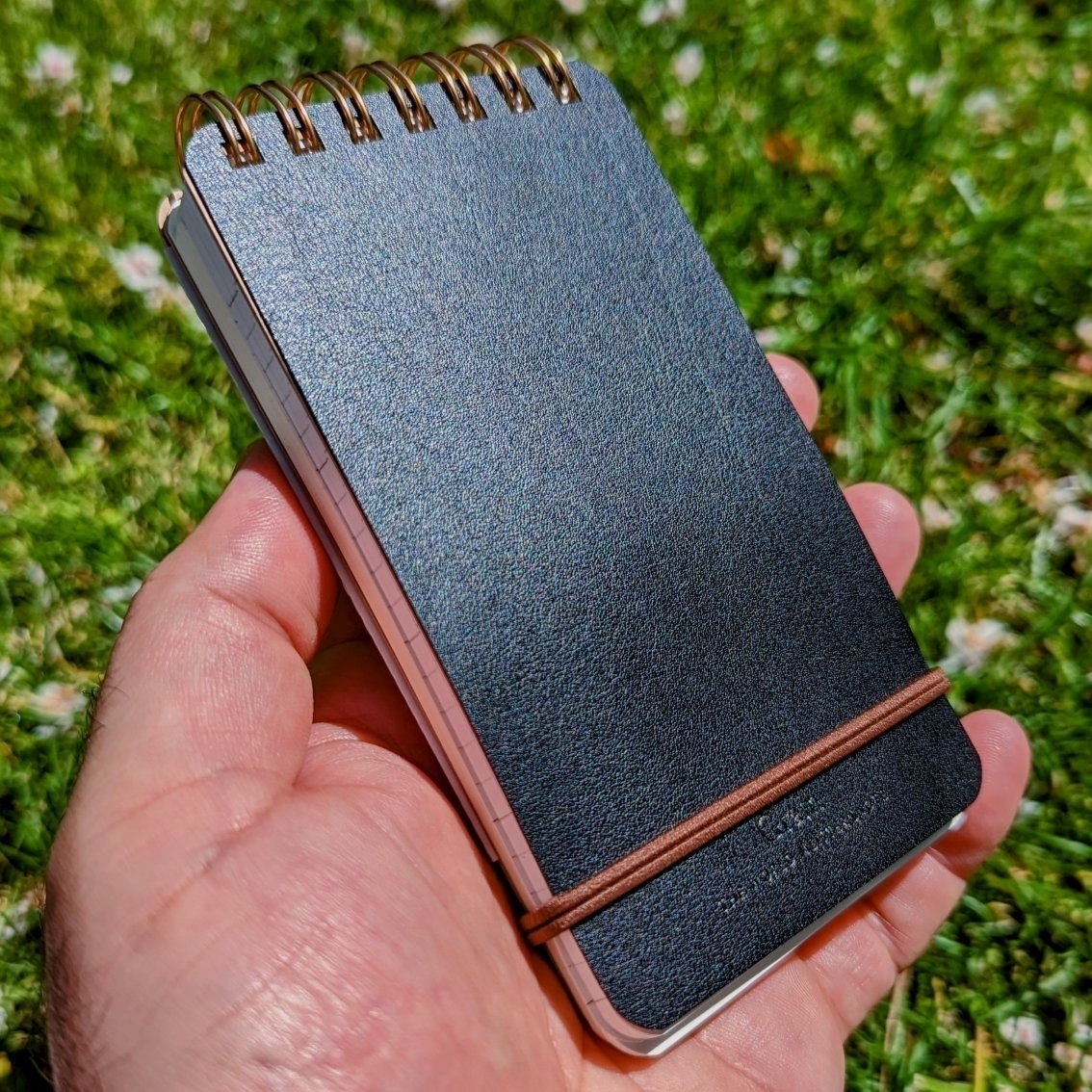
I switched to Google Tasks
I’ve recently switched to Google Tasks, and there are a few clues as to why in this post. But detailed information is coming soon. I’m currently working on a script for a video explaining the hacks I used to build my system and why it might be a better choice, depending on what Apps and devices you use.
And talking about tasks, there are many videos on my channel about Evernote Tasks and the tutorial below explaining how to set up and use the Obsidian Tasks plugin.




